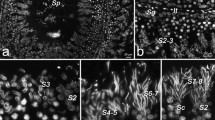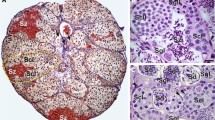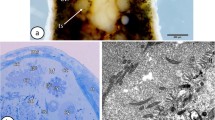Abstract
Changes inthe morphology and histologyofthe epididymis and seminal vesicle in male Atlantic stingrays (Dasyatis sabina) were examined in relation tothe seasonal reproductive cycle. Observations onthe size and structureofthese organs were accompanied by analysisof cell proliferation in genital duct epithelia using proliferating cell nuclear antigen (PCNA) as a marker for mitotic activity. No signsof reproductive tract growth or histological alteration were apparent duringthe initial stagesof spermatogenesis. However, increased PCNA expression inthe seminal vesicle epithelium was observed during this period, suggesting that this organ begins to undergo preparatory changes at an early stage inthe reproductive cycle. During late spermatogenesis, heightened expressionof PCNA in epithelial cellsofthe epididymis and seminal vesicle was observed in conjunction with dramatic increases in size and semen contentofthese organs. Extensive changes inthe histological architectureofthe genital ducts also were evident at this time, including regressionofthe stroma and an increase in size and secretory activityofthe epithelium. Althoughthe epididymis regressed in size and structure shortly after sperm production was completed,the seminal vesicle retained its appearance and activity forthe durationofthe 7-month copulatory period. Afterwards, immune cell content increased considerably in both ducts, likely reflecting clearanceof residual spermatozoa in preparation forthe subsequent reproductive season.the present study provides a basis for future reports onthe physiological regulationof reproductive tract function in elasmobranchs, and establishes PCNA immunocytochemistry as a novel tool for such investigations.
Similar content being viewed by others
References
Betka, M. and Callard, G.V. 1998. Negative feedback controlofthe spermatogenic progression by testicular oestrogen synthesis: insights fromthe shark testis model. APMIS 106: 252–258.
Bianco, J.J., Handelsman, D.J, Pedersen, J.S. and Risbridger, G.P. 2002. Direct responseofthe murine prostate gland and seminal vesicles to estradiol. Endocrinol. 143: 4922–4933.
Brooks, D.E. 1983. Epididymal functions andtheir hormonal regulation. Aust. J. Biol. Sci. 36: 205–221.
Callard, I.P., Klosterman, L. and Callard, G.V. 1988. Reproductive physiology. In: Physiologyof Elasmobranch Fishes, pp. 277–317. Edited by T.J. Shuttleworth. Springer-Verlag, Berlin.
Chaturapanich, G., Jones, R.C. and Clulow, J. 1992a. Protein synthesis and secretion bythe epididymisofthe tammar wallaby, Macropus eugenii(Macropodidae: Marsupialia). Reprod. Fertil. Dev. 4: 533–545.
Chaturapanich, G., Jones, R.C. and Clulow, J. 1992b. Roleof androgens in survivalof spermatozoa in epididymisof tammar wallaby (Macropus eugenii). J. Reprod. Fertil. 95: 421–429.
Chieffi, P., Franco, R., Fulgione, D. and Staibano, S. 2000. PCNA inthe testisofthe frog, Rana esculenta: a molecular markerofthe mitotic testicular epithelium proliferation. Gen. Comp. Endocrinol. 119: 11–16.
Chieffi, P., Nasti, M., Fulgione, D. and Franco, R. 2001. Expressionof PCNA inthe testisofthe lizard, Podarcis s. sicula: an endogenous molecular markerof mitotic germinal epithelium proliferation. Zygote 9: 317–322.
Chowdhury, I. and Joy, K.P. 2000. Effectsof administrationof testosterone on some biochemical correlates in seminal vesicleof Heteropneustes fossilis(Bloch) during preparatory phase: a study correlating changes in plasma testosterone level and testis activity. Indian J. Exp. Biol. 38: 713–719.
Clulow, J., Jones, R.C., Hansen, L.A. and Man, S.Y. 1998. Fluid and electrolyte reabsorption inthe ductuli efferentes testis. J. Reprod. Fertil. Suppl. 53: 1–14.
Clulow, J., Jones, R.C. and Murdoch, R.N. 1992. Maturation and regulationofthe motilityof spermatozoa inthe epididymisofthe tammar wallaby (Macropus eugenii). J. Reprod. Fertil. 94: 295–303.
Cooke, P.S., Young, P., Hess, R.A. and Cunha, G.R. 1991. Estrogen receptor expression in developing epididymis, efferent ductules, and other male reproductive organs. Endocrinol. 128: 2874–2879.
Eddy, E.M., Washburn, T.F., Bunch, D.O., Goulding, E.H., Gladen, B.C., Lubahn, D.B. and Korach, K.S. 1996. Targeted disruptionofthe estrogen receptor gene in male mice causes alterationof spermatogenesis and infertility. Endocrinol. 137: 4796–4805.
Feuchter, F.A., Tabet, A.J. and Green, M.F. 1988. Maturation antigenofthe mouse sperm flagellum. I. Analysisof its secretion, association with sperm, and function. Am. J. Anat. 181: 67–76.
Gilbert, P.W. and Wood, F.G. 1957. Methodof anesthetizing large sharks and rays safely and rapidly. Science 126: 212–213.
Gonzales, G.F. 2001. Functionof seminal vesicles andtheir role on male fertility. Asian J. Androl. 3: 251–258.
Guillette, L.J., Jr., Gross, T.S., Masson, G.R., Matter, J.M., Percival, H.F. and Woodward, A.R. 1994. Developmental abnormalitiesofthe gonad and abnormal sex hormone concentrations in juvenile alligators from contaminated and control lakes in Florida. Environ. Health Perspect. 102: 680–688.
Hamlett, W.C., Hysell, M.K., Rozycki, T., Brunette, N, Tumilty, K., Henderson, A. and Dunne, J. 1999. Sperm aggregation and spermatozeugmata formation inthe male genital ducts inthe clearnose skate, Raja eglanteria.In: Proceedingsofthe 5thIndo-Pacific Fish Conference Noumea, pp. 281–291. Edited by B. Séret and J.-Y. Sire. Soc. Fr. Ichtyol., Paris.
Hamlett, W.C., Reardon, M., Clark, J. and Walker, T.I. 2002. Ultrastructureof sperm storage and male genital ducts in a male holocephalan,the elephant fish, Callorhynchus milii.J. Exp. Zool. 292: 111–128.
Hess, R.A., Bunick, D., Lee, K.H., Bahr, J., Taylor, J.A., Korach, K.S. and Lubahn, D.B. 1997a. A role for oestrogens inthe male reproductive system. Nature 390: 509–512.
Hess, R.A., Gist, D.H., Bunick, D., Lubahn, D.B., Farrell, A., Bahr, J., Cooke, P.S. and Greene, G.L. 1997b. Estrogen receptor (alpha and beta) expression inthe excurrent ductsofthe adult male rat reproductive tract. J. Androl. 18: 602–611.
Hinton, B.T., Palladino, M.A., Rudolph, D., Lan, Z.J. and Labus, J.C. 1996.the roleofthe epididymis inthe protectionof spermatozoa. Curr. Top. Dev. Biol. 33: 61–102.
Johnson, M.R. and Snelson, F.F., Jr. 1996. Reproductive life historyofthe Atlantic stingray, Dasyatis sabina(Pisces: Dasyatidae), inthe freshwater St. Johns River, Florida. Bull. Mar. Sci. 59: 74–88.
Jones, R.C. and Clulow, J. 1994. Interactionsof sperm andthe reproductive ductsofthe male tammar wallaby, Macropus eugenii(Macropodidae: Marsupialia). Reprod. Fertil. Dev. 6: 437–444.
Jones, N. and Jones, R.C. 1982.the structureofthe male genital systemofthe Port Jackson shark, Heterodontus portjacksoni, with particular reference tothe genital ducts. Aust. J. Zool. 30: 523–541.
Jones, R.C., Jones, N. and Djakiew, D. 1984. Luminal composition and maturationof spermatozoa inthe male genital ductsofthe Port Jackson shark, Heterodontus portjacksoni.J. Exp. Zool. 230: 417–426.
Jones, R.C. and Lin, M. 1992. Ultrastructureofthe genital duct epitheliumofthe male Port Jackson shark, Heterodontus portjacksoni.Aust. J. Zool. 40: 257–266.
Jones, R.C. and Lin, M. 1993. Structure and functionofthe genital ductsofthe male Port Jackson shark, Heterodontus portjacksoni.Environ. Biol. Fish. 38: 127–138.
Jones, R.C. and Murdoch, R.N. 1996. Regulationofthe motility and metabolismof spermatozoa for storage inthe epididymisof eutherian and marsupial mammals. Reprod. Fertil. Dev. 8: 553–568.
Kajiura, S.M., Sebastian, A.P. and Tricas, T.C. 2000. Dermal bite wounds as indicatorsof reproductive seasonality and behaviour inthe Atlantic stingray, Dasyatis sabina.Environ. Biol. Fish. 58: 23–31.
Kajiura, S. and Tricas, T. 1996. Seasonal dynamicsof dental sexual dimorphism inthe Atlantic stingray, Dasyatis sabina.J. Exp. Biol. 199: 2297–2306.
Kaunisto, K.M. and Rajaniemi, H.J. 2002. Expression and localizationofthe Na+/H+ exchanger isoform NHE3 inthe rat efferent ducts. J. Androl. 23: 237–241.
Krutzsch, P.H. and Crichton, E.G. 1990. Reproductive biologyofthe male bent-winged bat, Miniopterus schreibersii(Vespertilionidae) in southeast South Australia. Acta. Anat. (Basel) 139: 109–125.
Kwon, S., Hess, R.A., Bunick, D., Kirby, J.D. and Bahr, J.M. 1997. Estrogen receptors are present inthe epididymisofthe rooster. J. Androl. 18: 378–384.
Lee, P.C. 1998. Disruptionof male reproductive tract development by administrationofthe xenoestrogen, nonylphenol, to male newborn rats. Endocrine 9: 105–111.
Madsen, P. and Celis, J.E. 1995. S-Phase patternsof cyclin (PCNA) antigen staining resemble topographical patternsof DNA synthesis. FEBS Lett. 193: 5–11.
Maruska, K.P., Cowie, E.G. and Tricas, T.C. 1996. Periodic gonadal activity and protracted mating in elasmobranch fishes. J. Exp. Zool. 276: 219–232.
McIntyre, B.S., Barlow, N.J., Sar, M., Wallace, D.G. and Foster, P.M. 2002. Effectsof in utero linuron exposure on rat Wolffian duct development. Reprod. Toxicol. 16: 131–139.
McLachlan, J.A., Newbold, R.R., Burow. M.E. and Li, S.F. 2001. From malformations to molecular mechanisms inthe male: three decadesof research on endocrine disrupters. APMIS 109: 263–272.
Misao, R., Fujimoto, J., Niwa, K., Morishita, S., Nakanishi, Y. and Tamaya, T. 1997. Immunohistochemical expressionsof estrogen and progesterone receptors in human epididymis at different ages-a preliminary study.Int. J. Fertil. Womens Med. 42: 39–42.
Piermarini, P.M. and Evans, D.H. 1998. Osmoregulationofthe Atlantic stingray (Dasyatis sabina) fromthe freshwater Lake Jesupofthe St. Johns River, Florida. Physiol. Zool. 71: 553–560.
Piermarini, P.M. and Evans, D.H. 2000. Effectsof environmental salinity on Na(+)/K(+)-ATPase inthe gills and rectal glandof a euryhaline elasmobranch (Dasyatis sabina). J. Exp. Biol. 203: 2957–2966.
Piermarini, P.M. and Evans, D.H. 2001. Immunochemical analysisofthe vacuolar proton-ATPase B-subunit inthe gillsof a euryhaline stingray (Dasyatis sabina): effectsof salinity and relation to Na(+)/K(+)-ATPase. J. Exp. Biol. 204: 3251–3259.
Piermarini, P.M., Verlander, J.W., Royaux, I.E. and Evans, D.H. 2002. Pendrin immunoreactivity inthe gill epitheliumof a euryhaline elasmobranch. Am. J. Physiol. Regul. Integr. Comp. Physiol. 283: R983–R992.
Reardon, M.B., Walker, T.I. and Hamlett, W.C. 2002. Microanatomyof spermatophore formation and male genital ducts inthe holocephalan, Callorhynchus milii.Mar. Freshwater Res. 53: 591–600.
Reyes-Moreno, C., Boilard, M., Sullivan, R. and Sirard, M.A. 2002. Characterizationof secretory proteins from cultured cauda epididymal cells that significantly sustain bovine sperm motility in vitro. Mol. Reprod. Dev. 63: 500–509.
Robaire, B. and Viger, R.S. 1995. Regulationof epididymal epithelial cell functions. Biol. Reprod. 52: 226–236.
Rooney, A.A., Bermudez, D.S. and Guillette, L.J., Jr. 2003. Altered histologyofthe thymus and spleen in contaminant-exposed juvenile American alligators. J. Morphol. 256: 349–359.
Singh, M.S. and Joy, K.P. 1997. Effectsof administrationof testosterone on seminal vesicle activity inthe catfish Clarias batrachusduring preparatory phase: a study correlating changes in testis and serum sex steroid levels. Acta Biol. Hung. 48: 421–430.
Sisneros, J.A. and Tricas, T.C. 2000. Androgen-induced changes inthe response dynamicsof ampullary electrosensory primary afferent neurons. J. Neurosci. 20: 8586–8595.
Snelson, F.F., Jr., Williams-Hooper, S.E. and Schmid, T.H. 1988. Reproduction and ecologyofthe Atlantic stingray, Dasyatis sabina, in Florida coastal lagoons. Copeia 1988: 729–739.
Snelson, F.F., Jr., Rasmussen, L.E. L., Johnson, M.R. and Hess, D.L. 1997. Serum concentrationsof steroid hormones during reproduction inthe Atlantic stingray, Dasyatis sabina.Gen. Comp. Endocrinol. 108: 67–79.
Stanley, H.P. 1963.the fine structureof spermatozoaof Hydrolagus collei(Chondrichthyes, Holocephali).J. Ultrastruct. Res. 83: 184–194.
Stefanini, M.A., Orsi, A.M., Gregorio, E.A., Viotto, M.J. and Baraldi-Artoni, S.M. 1999. Morphologic studyofthe efferent ductulesofthe pigeon (Columba livia). J. Morphol. 242: 247–255.
Sulik, M. and Guzinska-Ustymowicz, K. 2002. Expressionof Ki-67 and PCNA as proliferating markers in prostate cancer. Rocz. Akad. Med. Bialymst 47: 262–269.
Todhunter, R. and Gemmell, R.T. 1987. Seasonal changes inthe reproductive tractofthe male marsupial bandicoot, Isoodon macrourus.J. Anat. 154: 173–186.
Toft, G., Edwards, T.M., Baatrup, E. and Guillette, L.J., Jr. 2003. Disturbed Sexual Characteristics in Male Mosquitofish (Gambusia holbrooki) from a Lake Contaminated with Endocrine Disruptors. Environ. Health Perspect. 111: 695–701.
Tricas, T.C., Maruska, K.P. and Rasmussen, L.E.L. 2000. Annual cyclesof steroid hormone production, gonad development, and reproductive behavior inthe Atlantic stingray. Gen. Comp. Endocrinol. 118: 209–225.
Wang, Z.P., Gu, Z.P., Cao, L., Xu, Y., You, G.D., Mao, B.Y. and Qian, S.Z. 1999. Effectsof tripchlorolide onthe epididymides and testesof rats. Asian J. Androl. 1: 121–125.
Yuasa, H., Fukabori, Y., Ono, Y., Tomita, N., Suzuki, K. and Yamanaka, H. 1999. Immunohistochemical characteristicsof estrogen receptor alpha positive cells in glandular epitheliumofthe rat seminal vesicle. Tohoku J. Exp. Med. 187: 25–35.
Zhou, Q., Clarke, L., Nie, R., Carnes, K., Lai, L.W., Lien, Y.H., Verkman, A., Lubahn, D., Fisher, J.S., Katzenellenbogen, B.S. and Hess, R.A. 2001. Estrogen action and male fertility: rolesofthe sodium/hydrogen exchanger-3 and fluid reabsorption in reproductive tract function. Proc. Natl. Acad. Sci. USA 98: 14132–14137.
Author information
Authors and Affiliations
Rights and permissions
About this article
Cite this article
Piercy, A., Gelsleichter, J. & Snelson, F. Morphological and histological changes inthe genital ducts ofthe male Atlantic stingray, Dasyatis sabina, during the seasonal reproductive cycle. Fish Physiology and Biochemistry 29, 23–35 (2003). https://doi.org/10.1023/B:FISH.0000035894.45256.59
Issue Date:
DOI: https://doi.org/10.1023/B:FISH.0000035894.45256.59




